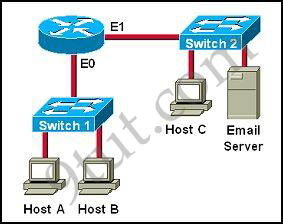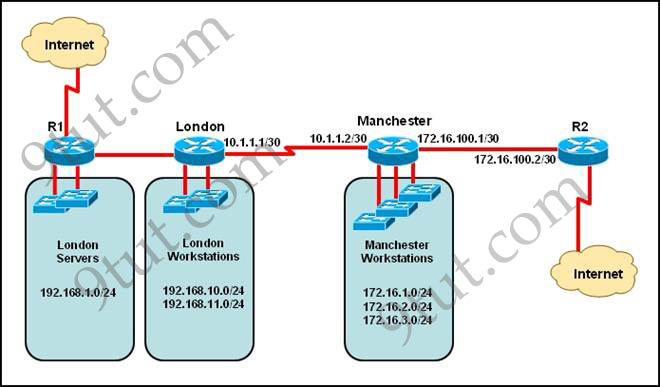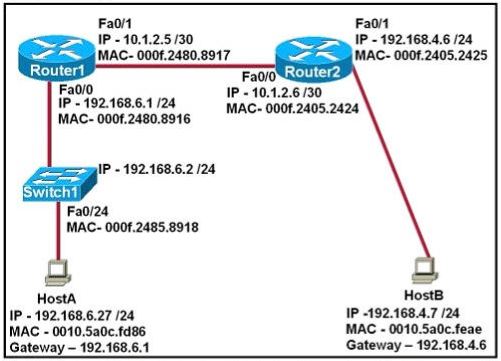New CCNA – IP Routing 2
Question 1
Users on the 172.17.22.0 network cannot reach the server located on the 172.31.5.0 network. The network administrator connected to router Coffee via the console port, issued the show ip route command. Based on the output of the show ip route command and the topology shown in the graphic, what is the cause of the failure?

A. The network has not fully converged.
B. IP routing is not enabled.
C. A static route is configured incorrectly.
D. The FastEthernet interface on Coffee is disabled.
E. The neighbor relationship table is not correctly updated.
F. The routing table on Coffee has not updated.
Answer: C
Explanation
There are no dynamic routing protocols running on Coffee router, only a default route is configured to route all traffic to 172.19.22.2 but we don’t know about this network. The correct IP address should be the IP address on the interface of Tea router which is connected to Coffee router (maybe 172.18.22.2).
Question 2
The speed of all serial links is E1 and the speed of the all other links is 100Mb/s. A static route will be established on the Manchester router to direct traffic toward to the internet over the most direct path available. What configuration of the Manchester router will establish a route toward to the internet for traffic from workstation on the Manchester LAN?

A. ip route 0.0.0.0 255.255.255.0 172.16.100.2
B. ip route 0.0.0.0 255.255.255.252 128.107.1.1
C. ip route 0.0.0.0 0.0.0.0 128.107.1.1
D. ip route 0.0.0.00.0:0:0 172.16.100.1
E. ip route 0.0.0.0 255.255.255.255 172.16.100.2
F. ip route 0.0.0.0 0.0.0.0 172.16.100.2
Answer: F
Explanation
Maybe “the most direct path available” here means via R2 because it is directly connected with the Internet while the London path needs to go through R1. So we need a command to send traffic to R2 and the correct command is “ip route 0.0.0.0 0.0.0.0 172.16.100.2″.
Question 3
Which two are advantages of static routing when compared to dynamic routing? (choose two)
A. Security increases because only the network administrator may change the routing tables.
B. Configuration complexity decreases as network size increases.
C. Routing updates are automatically sent to neighbors.
D. Route summarization is computed automatically by the router.
E. Routing traffic load is reduced when used in stub network links.
F. An efficient algorithm is used to build routing tables using automatic updates.
G. Routing tables adapt automatically to topology changes.
Answer: A E
Question 4
Refer to the exhibit. According to the routing table, where will the router send a packet destined for 10.1.5.65?
| Network | Interface | Next-hop |
| 10.1.1.0/24 | e0 | directly connected |
| 10.1.2.0/24 | e1 | directly connected |
| 10.1.3.0/25 | s0 | directly connected |
| 10.1.4.0/24 | s1 | directly connected |
| 10.1.5.0/24 | e0 | 10.1.1.2 |
| 10.1.5.64/28 | e1 | 10.1.2.2 |
| 10.1.5.64/29 | s0 | 10.1.3.3 |
| 10.1.5.64/27 | s1 | 10.1.4.4 |
A. 10.1.1.2
B. 10.1.2.2
C. 10.1.3.3
D. 10.1.4.4
Answer: C
Explanation
The destination IP address 10.1.5.65 belongs to 10.1.5.64/28, 10.1.5.64/29 & 10.1.5.64/27 subnets but the “longest prefix match” algorithm will choose the most specific subnet mask -> the prefix “/29″ will be chosen to route the packet. Therefore the next-hop should be 10.1.3.3 -> C is correct.
Question 5
Which destination addresses will be used by Host A to send data to Host C? (Choose two)

A. the IP address of Switch 1
B. the MAC address of Switch 1
C. the IP address of Host C
D. the MAC address of Host C
E. the IP address of the router’s E0 interface
F. the MAC address of the router’s E0 interface
Answer: C F
Explanation
While transferring data through many different networks, the source and destination IP addresses are not changed. Only the source and destination MAC addresses are changed. So in this case Host A will use the IP address of Host C and the MAC address of E0 interface to send data. When the router receives this data, it replaces the source MAC address with it own E1 interface’s MAC address and replaces the destination MAC address with Host C’s MAC address before sending to Host C -> C and F are correct.
Question 6
Refer to the exhibit. The network administrator must establish a route by which London workstations can forward traffic to the Manchester workstations. What is the simplest way to accomplish this?

A. Configure a dynamic routing protocol on London to advertise all routes to Manchester.
B. Configure a dynamic routing protocol on London to advertise summarized routes to Manchester.
C. Configure a dynamic routing protocol on Manchester to advertise a default route to the London router.
D. Configure a static default route on London with a next hop of 10.1.1.1.
E. Configure a static route on London to direct all traffic destined for 172.16.0.0/22 to 10.1.1.2.
F. Configure Manchester to advertise a static default route to London.
Answer: E
Question 7
Which parameter can be tuned to affect the selection of a static route as a backup when a dynamic protocol is also being used?
A. link bandwidth
B. hop count
C. link cost
D. administrative distance
E. link delay
Answer: D
Question 8
Refer to the exhibit:

After HostA pings HostB, which entry will be in the ARP cache of HostA to support this transmission?
A.

B.

C.

D.

E.

F.

Answer: D
Explanation
Host A knows host B is in another network so it will send the pings to its default gateway 192.168.6.1. Host A sends a broadcast frame asking the MAC address of 192.168.6.1. These information (IP and MAC address of the default gateway) is saved in its ARP cache for later use.



@9tut
question 8.. why the answer is not A.. still didn’t get to it
for question #8,
i don t understand why the answer is D, is it not supposed to be A ?
when we know that host B is the destination IP address and the source mac address of router is that Router 1
Well for question 8 whenever host A gets a reply from host B, we know that it will get the ip address of host B which is never changed but router1 will change the destination mac address with mac address of its e0 interface before sending it to host A.
can ne1 pls explain Q7.. how we can tune AD???
its not fixed ?
Q5 On 15th Feb.
@Che how many question were from 9tut?
Question 8.. Answer is A.
Admin do your review. Great job
Question 8, since host B is on a separate subnet (by doing the “anding” calculation), host A will just going to send the packet to its registered default gateway…it’s just like when you ping a website from your home LAN, your PC knows that the website’s server is on an outside network so it will just send the packet to your router/modem (default gateway) which will take care the routing.
re: Q8: Host A’s ping leaves its own subnet so it must use its configured default gateway (192.168.6.1). The ARP request from Host A goes out looking for the MAC corresponding to its default gateway — IP addr 192.168.6.1; Router1 responds with the MAC of its fa0/0 interface. Once Host A gets the fa0/0 MAC address, the ping heads to fa0/0 from Host A with a MAC dest of fa0/0 and an IP dest of Host B. The answer listed in Q8 is correct.
There you can find why answer D is correct in Q8
http://serverfault.com/questions/397350/what-happens-when-arp-request-comes-from-a-different-subnet
@Che
Q7 is right, look in google for Floating Static Routes
IS TAB AND ? IS WORKING IN EXAM???
I pass today 916, if anyone want to share e-mail me reply.chirag@hotmail.com
Thanks 9tut, passed today with a score of 986. Question 8 was on there.
ccna is so bullshit
Hi crbuk how many Qs from 9TUT in your exam ? did you just studied with 9tut or DUMP_EXAM?
Passed my CCNA exam today (18th Mar)… Q1 in exam
Hi Apush,
so were the sims ACL1,ACL2 n EIGRP just like everyone else were saying?
Please send me the latest CCNA dump I am planning to take the exam on 2 week of april.
my email add is abruduhragna@gmail.com.
Thank you so much. :)
can some one tell me the correct answer for q8
Q2 – Ir is rather the presence of the serial link between London and Manchester that makes the route through R1 less favourable.
Q5
Q8: I simulated in packet tracer and aswer was A. How is this possible ?
Are you sure, that D is correct aswer ?
Hi TOM,
I am sure the correct answer for Q-8 is ‘D’. The question is asking about the ARP entry not the actual packet being sent from Host A to Host B.
When the Host ‘A’ comes to know that the Host B is not in his subnet, it will sent ARP msg asking about the MAC address of its default gateway router. Router will respond with its MAC address. Which Host A will store in ARP cache.
Q 8 is A no D
Q 8 is A no D the destination ip address always is 192.168.4.7, the destination ip does not change..
I am sure the correct answer for Q-8 is ‘A’ because in the ICND 1 curricula is explained this situation.. in other questions is the answer for this
the arp request and arp replay never change de destination ip addrres is un protocol that only is used in layer 2, use only directions layer 2 in its process
q4 1000/1000
there is nothing wrong with question 8′s answer bring D.
Am writting on monday.
Hi Zover@ss, please send me the latest dumps as I am planning to give the exam in first week of may. Thank u aashishmehta1982@gmail.com
Zovers@ss, what material will recommend me to study, can you please send me the latest dumps @ polarbeer2000@hotmail.com. Have my exams on Tuesday I’ll appreciate any help. Tkx.
pleas send to me also the last dumps esmatedris@hotmail.com
@Zovers@ss: Please share dumps at zameer.ise@gmail.com.
Thank You
Hi everyone, Please send me the latest CCNA dump. I am planning to take the exam in 2 days.
my email is techcompa2015@gmail.com.
Thank you so much :-D
Zovers@ss, what material will recommend me to study, can you please send me the latest dumps @ jmayur777@gmail.com. my exam on 29th may. pls
@Zovers@ss: Please share dumps at mxsoud@gmail.com
Thank You
@Zovers@ss: Please share dumps at dipendrasingh.singh1990@gmail.com
thanks in advance
Please send me the link for latest free vce full version @ youimprovedalot@gmail.com
can somebody send me new ccna dumbs……dk44418@gmail.com